Sand and Deliver
Paul Copsey has been the Course Manager at Orpington Golf Centre since August 1994. Comprising of two courses, Cray Valley and Ruxley Park, the two clubs were, originally, under different ownership. Now jointly owned by Crown Golf, both courses have 18 hole layouts along with a full length 9 hole course at Cray Valley, a 9 hole short course at Ruxley and a driving range.
 In 1998 Paul's role was expanded to Regional Superintendent /Course Manager, AG (UK), during the expansion of the company's portfolio from five to thirty-three properties.
In 1998 Paul's role was expanded to Regional Superintendent /Course Manager, AG (UK), during the expansion of the company's portfolio from five to thirty-three properties.
Both courses at Orpington Golf Centre were constructed in the early 1970s with, it has to be said, rather dubious design, construction methods and materials. Situated on the boundary between north Kent and south east London, they were built to satisfy a mini boom in demand for golf and, in particular, pay and play facilities.
There had been precious little thought put into the original layout and, equally, very little investment during the late 1970s and 1980s. Both courses degenerated into the pay and play or 'municipal norm' of poor turf quality, excessive wear areas and poor winter playability, with poor drainage, especially on the greens.
During the early 1990s these poor quality issues resulted in the owners seeing dwindling memberships and less casual play, resulting in the sale of both courses to American Golf (AG). The property passed to Crown Golf in 2004 with the purchase of AG (UK), bringing the Crown portfolio to thirty-three sites.
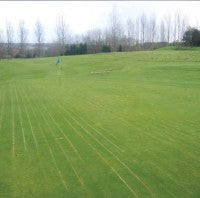 Even in the years since, with comparatively major injections of capital and a more professional approach to maintenance and budgeting, the majority of greens still performed poorly, despite all normal thatch control, aeration, sand dressing and agronomic practices on a very intensive schedule.
Even in the years since, with comparatively major injections of capital and a more professional approach to maintenance and budgeting, the majority of greens still performed poorly, despite all normal thatch control, aeration, sand dressing and agronomic practices on a very intensive schedule.
Some peripheral drainage and main line drainage was installed into some of the greens, but the heavy clay base that was pushed up to form the mounding to the greens and surrounds, could not be overcome. Water literally sat on top of this material that would be better used for making pots out of!
Ironically, this may have been the wish of the original owners who, with a great deal of foresight, never envisaged the need to install automatic irrigation, the idea being that the clay would stay wet all summer from winter rains. As we all know, this is not the case, especially from a playing point of view. All you actually end up with is a hard biscuit in the summer and soft goo in the winter, not exactly ideal.
Subsequent installation of a very poor specification irrigation system in the early 1980s satisfied the summer customers but, not surprisingly, just made matters worse for winter play and for business.
From 1994 the foundations were laid for a much more considered and better budgeted maintenance regime, which continued in the conventional way for a number of years.
We had been experimenting with a number of lateral main drains and secondary drainage techniques, such as the Shelton Gravel Bander, with mixed results. We were stuck with the reality that we could never get water through the greens. Digging them up, given the number affected, was a complete non-starter, both financially and for disruption to play.
 Trying to move water, or give it the ability to move sideways towards the peripheral, more traditional drain lines we had previously installed with our own AFT whizz wheel trencher, seemed the most practical option. How we were affectively going to achieve this on a busy site, and cost effectively, did not really seem apparent until Gary Mumby brought one of his early Blec Sand Masters to do a trial on one of our greens. I think, at first, he was a little hesitant, as I thing it was envisaged for sportsturf use, but perhaps not golf greens that were normally mown down to 4-5mm.
Trying to move water, or give it the ability to move sideways towards the peripheral, more traditional drain lines we had previously installed with our own AFT whizz wheel trencher, seemed the most practical option. How we were affectively going to achieve this on a busy site, and cost effectively, did not really seem apparent until Gary Mumby brought one of his early Blec Sand Masters to do a trial on one of our greens. I think, at first, he was a little hesitant, as I thing it was envisaged for sportsturf use, but perhaps not golf greens that were normally mown down to 4-5mm.
As with most operations, it is the preparation and aftercare that are important. The machine and operation of dropping the sand into the slits cut by the rotating blades was very impressive, but we were just as interested to see the potential for recovery time and subsequent performance of the putting surface in the following winter. This trial was very successful and, encouraged by the results, we contracted ALS to perform the operation in the last week of October 2007.
ALS used the 1.5 metre wide machine on an 80hp tractor on flotation tyres. We were lucky that the greens we wanted to do had areas with reasonable access for turning, otherwise the one metre machine that we had originally used would have been more appropriate. The upside of the extra width however was, obviously, the reduced time taken to perform the operation. ALS had two guys on site and, apart from the Sand Master and tractor, had a Bobcat skid steer loader. another tractor and a Dakota topdresser fitted with a conveyor for easy loading of the Sand Master's hopper.
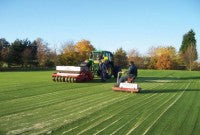 The loading element was the key to the reduced operation time especially as, after initial setting, we were inserting five tonnes of Redhill 28 sand into each green via the slits made by the machine. Most greens were completed in under an hour, with immediate rolling then taking place with a turf iron.
The loading element was the key to the reduced operation time especially as, after initial setting, we were inserting five tonnes of Redhill 28 sand into each green via the slits made by the machine. Most greens were completed in under an hour, with immediate rolling then taking place with a turf iron.
The green was only out of play while the machinery was carrying out the operation, so Orpington Golf Centre being Orpington Golf Centre (never closing, never having temporary greens, never banning trolleys, never having tee mats, etc.) a new hole was immediately re cut in the green and returned into play! It was then dressed with two tonnes of sand and dragmatted into the surface. Again the same sand was used for dressing as inserted into the green by the Sand Master so, effectively, seven tonnes was going into and onto every green.
Unusually, this particular week in October was especially dry, so the green was irrigated for a few minutes after completion just to settle in the sand and give a clean appearance to the surface.
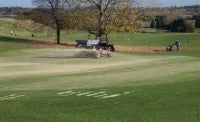 Nature being nature, about four days later we had a deluge but, to be honest, this was almost perfect timing. The contractors were on site for three days, completing work to nineteen greens at a cost of £6,500. For the material cost during and in the immediate dressing work we used just over 120 tonnes of Redhill 28 sand at a cost of approximately £2,700, which equates to under £500 per green for the total operation.
Nature being nature, about four days later we had a deluge but, to be honest, this was almost perfect timing. The contractors were on site for three days, completing work to nineteen greens at a cost of £6,500. For the material cost during and in the immediate dressing work we used just over 120 tonnes of Redhill 28 sand at a cost of approximately £2,700, which equates to under £500 per green for the total operation.
Before elaborating on our aftercare programmeme, it is well worth stating that we took some measures prior to the operation to make sure the turf was strong enough, healthy enough and as well rooted as possible. Only on one green, in one corner, did we see any evidence of the turf lifting and stretching, leaving a rippled surface.
To just pile in with this kind of machinery on weak turf would have been potentially disastrous and taken many months to recover, rather than the almost instant effect we managed to obtain.
We actually have a fairly intensive aeration programme under normal circumstances, but the last aeration we performed, prior to ALS coming in, was mini hollow coring during the last week of August and the first week of September.
I felt it was important to keep up moisture levels, whilst trying to guard against over watering and making the greens too soft, so we continued to hand water the greens, using the wetting agent pellets, and intensified our policy of applying a soil penetrant (Inflo XL) via the sprayer at four week intervals, to tow week intervals through the late summer period.
This is normal practice, not only to eliminate the effects of dry patch, but helps keeps surfaces dry and dew free (frost free in winter), keeps the moisture moving down into the soil (remember we do not have rootzone - our larger particles are normally house bricks) and, subsequently, reduces the risk of disease.
In addition we intensified our feeding programme by just upping the regularity with which we applied our liquid and soluble products. We base these on two simple products, Go Green Plus and the Seavolution seaweed product to which we can then add soluble or liquid elements at varying rates to suit the seasonal conditions.
It is probably also worth mentioning that we add Trinexapac-ethyl (Shortcut and now Primo Maxx) as a growth suppressant to the tank mixes, not just to reduce clippings, but tighten down the turf and keep the nutrient in the plant making it tougher and healthier.
Another regular additive was, and continues to be, P Kursor, a phosphite product to maintain plant health and help in the fight against disease. In essence, therefore, I felt we had prepared the greens for the mechanical onslaught they were about to undergo.
 In reality, after the operation, it could be said that it was "business as usual" for late autumn and winter maintenance but, again, with a more intensified bias. For about a month after the operation the greens were rolled every two days with the turf iron and mown two times per week at a height of 6mm. Topdressing continued. Another one tonne of sand was applied one week after, and then reduced to 0.5 tonne per green at weekly intervals for the following four weeks.
In reality, after the operation, it could be said that it was "business as usual" for late autumn and winter maintenance but, again, with a more intensified bias. For about a month after the operation the greens were rolled every two days with the turf iron and mown two times per week at a height of 6mm. Topdressing continued. Another one tonne of sand was applied one week after, and then reduced to 0.5 tonne per green at weekly intervals for the following four weeks.
Again, the soluble feeding programme and tank mixes continued throughout the winter. It must be stressed that intensive linear aeration or scarifying to fine turf causes stress as the turf tries to recover itself. I have often seen this lead to very weak and sorry looking surfaces that just lay themselves open to rampant attacks of fusarium.
In my opinion, it should be more widely reported that under feeding turf, in many circumstances, is just as poor practice as over feeding. Simple, sweeping statements about "sustainability" or by "Gingerbread Men" perhaps need countering or qualifying by more in depth comment and analysis on feeding techniques, practices, product types and practical circumstances.
Aeration did not take place again until January 2008, when the greens were slit tined. An overall strategy is one key factor that I feel is very important to get right after the operation (and not a bad idea in normal circumstances anyway).
The important thing to remember here is that we are talking about soil based greens with a heavy clay content. My first sweeping statement is that I think that too many people get carried away with trying to use too big a tine and going in at too great a depth, for two reasons. The first, because they can and secondly because they can and they think this gives the best benefit, but it causes the most disruption and antagonises the golfing customers.
This leads to a cycle of "less and infrequent" at many clubs, rather than "little and often". In my opinion using too big a tine on soil greens at too great a depth can further destroy your soil structure and green performance, especially going into and during winter, whether hollow or solid. You just end up with a deep file of air or more pore spaces in fractured soil that can fill up with water as soon as it rains.
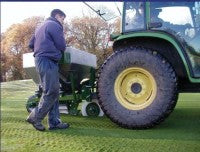
Once they get wet, they will not start drying out until the spring, actually compounding all the problems of black layer, thatch, disease etc., with or without sand bands. In a soil based or clay based green, unless you can hit a permeable layer some way down, you are just going to make them wetter.
For the past ten years we have got into the habit of using small 12mm diameter round tines, and only going in at between 4"- 6", from late winter through to midsummer on a 50mm square pattern at about four weekly intervals. This commenced again in March 2008.
Our hollow coring is carried out in late August and early September (it takes about three weeks to get round the 57 greens). This year, for the first time, I used the best machine I have ever used for this, my new Wiedenmann GXi.
Wiedenmann do an excellent 12mm outer diameter tine with a 5mm diameter inner. The result was a super smooth putting surface at 50mm hole spacings at 4" depth - and two Gator loads of cores to tip from each green. We only do this operation from 6.00am until 9.00am each morning, Monday to Thursday inclusive. All the cores are cleared and the greens dressed, matted and rolled. To be honest, the golfers don't even know we have done it; - it just looks like one of our normal, light sand dressings has been carried out.
Early October saw the last solid tining, again with the 12mm tines to a depth of 6". From November to January the greens were slit tined once a month.
I have almost got to the stage of allowing a certain amount of rain to run off a firmer surface, as the water going into the soil/clay base just compounds the problem. Also these small drain lines will not suck water away in any great volume. 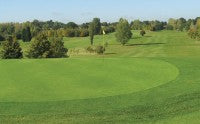
We are now opening up the top to allow the sand bands to do their work at their own rate. For the sand lines, too big a tine would let too much water in, they would not cope or move the water any better, in fact a learned drainage machine designer and manufacturer of gravel banders once told me that he thought that the use of a vertidrain with ¾ tines just destroyed and broke up the integrity of the drainage lines and allowed the ingress of more soil and silt particles.
In summary, by the spring, we had total recovery to a point where there was no evidence of any lines appearing in the turf surface. The surfaces throughout the summer were probably the smoothest and most consistent they have even been. Even only mowing at 5mm they were too quick for the majority of our customers stimping at about 8.5 - 9.0 (to achieve this the previous summer we were mowing at 4mm).
They will never perform, dry out or give you the filtration rates like a sand green, but help you get over the worst of the softness and water retention. This can assist in the fight against thatch and black layer, and give you half a chance.
I did tend to have to put a couple of mm more water on via the automatic irrigation system when we did have the odd dry spell and it did take a bit of getting used to. Now, through this winter they are still performing admirably - we always play in ice, frost, rain - you name it, we don't have temporaries or ban trolleys.
We are still triplex mowing greens two times per week at 6mm and have much improved surfaces. They obviously cannot shift as much water after a large amount of rain as a sand based green, but their drying time is much quicker than before.
It has not been immediately obvious to us that the drier surfaces have yielded any less occurrences of disease, as we have not unduly suffered with this problem anyway - we should have, given the nature of soil push up greens. But, our normal last resort, to spray an application of fungicide tank mix two times per year will continue in the same vein.
Fusarium is our only challenge as we only occasionally see minor occurrences of dollar spot, anthracnose, or take all patch, which we normally counter by agronomic means other than using a fungicide.
One observation. Despite not actively applying or resorting to an overseeding programme, it has been evident that, in certain areas of these greens, we now see small patches of natural bent appearing; perhaps the first indication that, coupled to a sensible maintenance regime, in pretty difficult circumstances, conditions can now start to swing towards more favourable surface conditions.
This should keep the "sustainable" prophets happy, but I can't say my customers will notice the individual grass species in my predominantly poa putting surfaces. The fact that they are in play 365 day per year, firmer, and have full healthy grass cover is their main priority.
It is noticeable that many private golf club members from the local area sheepishly sneak onto our courses during the autumn, winter and early spring period. Play in general is on the up, despite economic pressure, a recession and talk of a downturn in golf business.
Reasonable quality at the right price, or for us, an improvement in what we can offer, has been a real advantage and a testament to a very small, talented and loyal team here at Orpington - the engineering excellence of Gary Mumby, the skill of the two operators from ALS and what can be achieved with a well prepared and considered maintenance plan, with a clear objective.
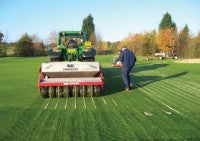 The Sand Master operation for draining clay based push up greens may not be the answer to everyone's prayers, but it does give 'half a chance' in helping a normal maintenance routine achieve higher and better results.
The Sand Master operation for draining clay based push up greens may not be the answer to everyone's prayers, but it does give 'half a chance' in helping a normal maintenance routine achieve higher and better results.
It is important that the sand lines link into, or over, a previously installed drain line or system and the sand drain lines will not magically suck away your water or give you rock hard greens in the middle of a very wet January, but at least you will be on a better footing and have better playability.
How long these benefits will last, only time will tell. It may be that, in six years time, we might need to repeat the operation, especially on the greens where the clay base is particularly poor, but at least we are now more confident that this has been a successful project yielding excellent results and has actually attracted more customers, business and income. It has been a very cost-effective exercise with relatively little disruption. So far, so good.
